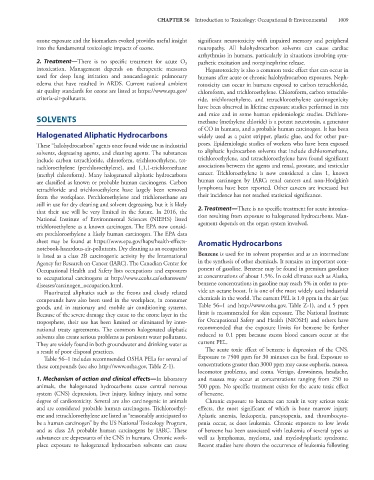Page 1023 - Basic _ Clinical Pharmacology ( PDFDrive )
P. 1023
CHAPTER 56 Introduction to Toxicology: Occupational & Environmental 1009
ozone exposure and the biomarkers evoked provides useful insight significant neurotoxicity with impaired memory and peripheral
into the fundamental toxicologic impacts of ozone. neuropathy. All halohydrocarbon solvents can cause cardiac
arrhythmias in humans, particularly in situations involving sym-
2. Treatment—There is no specific treatment for acute O pathetic excitation and norepinephrine release.
3
intoxication. Management depends on therapeutic measures Hepatotoxicity is also a common toxic effect that can occur in
used for deep lung irritation and noncardiogenic pulmonary humans after acute or chronic halohydrocarbon exposures. Neph-
edema that have resulted in ARDS. Current national ambient rotoxicity can occur in humans exposed to carbon tetrachloride,
air quality standards for ozone are listed at https://www.epa.gov/ chloroform, and trichloroethylene. Chloroform, carbon tetrachlo-
criteria-air-pollutants. ride, trichloroethylene, and tetrachloroethylene carcinogenicity
have been observed in lifetime exposure studies performed in rats
and mice and in some human epidemiologic studies. Dichloro-
SOLVENTS methane (methylene chloride) is a potent neurotoxin, a generator
of CO in humans, and a probable human carcinogen. It has been
Halogenated Aliphatic Hydrocarbons widely used as a paint stripper, plastic glue, and for other pur-
These “halohydrocarbon” agents once found wide use as industrial poses. Epidemiologic studies of workers who have been exposed
solvents, degreasing agents, and cleaning agents. The substances to aliphatic hydrocarbon solvents that include dichloromethane,
include carbon tetrachloride, chloroform, trichloroethylene, tet- trichloroethylene, and tetrachloroethylene have found significant
rachloroethylene (perchloroethylene), and 1,1,1-trichloroethane associations between the agents and renal, prostate, and testicular
(methyl chloroform). Many halogenated aliphatic hydrocarbons cancer. Trichloroethylene is now considered a class 1, known
are classified as known or probable human carcinogens. Carbon human carcinogen by IARC; renal cancers and non-Hodgkin’s
tetrachloride and trichloroethylene have largely been removed lymphoma have been reported. Other cancers are increased but
from the workplace. Perchloroethylene and trichloroethane are their incidence has not reached statistical significance.
still in use for dry cleaning and solvent degreasing, but it is likely 2. Treatment—There is no specific treatment for acute intoxica-
that their use will be very limited in the future. In 2016, the tion resulting from exposure to halogenated hydrocarbons. Man-
National Institute of Environmental Sciences (NIEHS) listed agement depends on the organ system involved.
trichloroethylene as a known carcinogen. The EPA now consid-
ers perchloroethylene a likely human carcinogen. The EPA data
sheet may be found at https://www.epa.gov/haps/health-effects- Aromatic Hydrocarbons
notebook-hazardous-air-pollutants. Dry cleaning as an occupation
is listed as a class 2B carcinogenic activity by the International Benzene is used for its solvent properties and as an intermediate
Agency for Research on Cancer (IARC). The Canadian Center for in the synthesis of other chemicals. It remains an important com-
Occupational Health and Safety lists occupations and exposures ponent of gasoline. Benzene may be found in premium gasolines
to occupational carcinogens at http://www.ccohs.ca/oshanswers/ at concentrations of about 1.5%. In cold climates such as Alaska,
diseases/carcinogen_occupation.html. benzene concentrations in gasoline may reach 5% in order to pro-
Fluorinated aliphatics such as the freons and closely related vide an octane boost. It is one of the most widely used industrial
compounds have also been used in the workplace, in consumer chemicals in the world. The current PEL is 1.0 ppm in the air (see
goods, and in stationary and mobile air conditioning systems. Table 56–1 and http://www.osha.gov, Table Z-1), and a 5 ppm
Because of the severe damage they cause to the ozone layer in the limit is recommended for skin exposure. The National Institute
troposphere, their use has been limited or eliminated by inter- for Occupational Safety and Health (NIOSH) and others have
national treaty agreements. The common halogenated aliphatic recommended that the exposure limits for benzene be further
solvents also create serious problems as persistent water pollutants. reduced to 0.1 ppm because excess blood cancers occur at the
They are widely found in both groundwater and drinking water as current PEL.
a result of poor disposal practices. The acute toxic effect of benzene is depression of the CNS.
Table 56–1 includes recommended OSHA PELs for several of Exposure to 7500 ppm for 30 minutes can be fatal. Exposure to
these compounds (see also http://www.osha.gov, Table Z-1). concentrations greater than 3000 ppm may cause euphoria, nausea,
locomotor problems, and coma. Vertigo, drowsiness, headache,
1. Mechanism of action and clinical effects—In laboratory and nausea may occur at concentrations ranging from 250 to
animals, the halogenated hydrocarbons cause central nervous 500 ppm. No specific treatment exists for the acute toxic effect
system (CNS) depression, liver injury, kidney injury, and some of benzene.
degree of cardiotoxicity. Several are also carcinogenic in animals Chronic exposure to benzene can result in very serious toxic
and are considered probable human carcinogens. Trichloroethyl- effects, the most significant of which is bone marrow injury.
ene and tetrachloroethylene are listed as “reasonably anticipated to Aplastic anemia, leukopenia, pancytopenia, and thrombocyto-
be a human carcinogen” by the US National Toxicology Program, penia occur, as does leukemia. Chronic exposure to low levels
and as class 2A probable human carcinogens by IARC. These of benzene has been associated with leukemia of several types as
substances are depressants of the CNS in humans. Chronic work- well as lymphomas, myeloma, and myelodysplastic syndrome.
place exposure to halogenated hydrocarbon solvents can cause Recent studies have shown the occurrence of leukemia following

